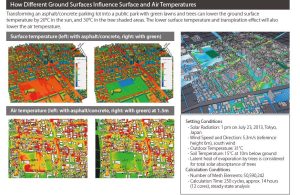
Optimizing Urban Heat Island Mitigation with Cradle CFD: Advanced Techniques and Practical Applications
Urban areas, with their concrete jungles and high human activity, often experience significantly higher temperatures than their rural surroundings. This phenomenon, known as the Urban Heat Island (UHI) effect, can lead to a range of environmental and health issues. As cities continue to grow, understanding and mitigating UHI becomes increasingly critical. Computational Fluid Dynamics (CFD) has emerged as a powerful tool in this endeavor, and Cradle CFD software stands out as a leading solution in the field. Understanding the Urban Heat Island Effect The UHI effect occurs due to various factors, including reduced vegetation, increased impervious surfaces, and heat generated from buildings, vehicles, and industrial activities. These factors contribute to the absorption and retention of heat, leading to higher temperatures in urban areas compared to their rural counterparts. The consequences of UHI are far-reaching, impacting energy consumption, air quality, and public health. The Role of Cradle CFD in UHI Analysis Cradle CFD software, known for its robust simulation capabilities, offers a comprehensive suite of tools for analyzing and mitigating the UHI effect. By simulating airflow, temperature distribution, and pollutant dispersion, Cradle CFD enables urban planners, architects, and environmental engineers to develop effective strategies for reducing urban heat. Key Features of Cradle CFD for UHI Analysis High-Resolution Simulations: Cradle CFD provides high-resolution simulations that capture the intricate details of urban environments. This level of detail is crucial for accurately predicting temperature variations and identifying hotspots within the city. Realistic Boundary Conditions: The software allows users to input realistic boundary conditions, such as solar radiation, building materials, and surface properties. This ensures that the simulations closely replicate real-world scenarios, providing reliable data for decision-making. Advanced Turbulence Models: Cradle CFD incorporates advanced turbulence models, including Large Eddy Simulation (LES) and Reynolds-Averaged Navier-Stokes (RANS) models, that accurately simulate airflow patterns in complex urban landscapes. Understanding these patterns is essential for designing effective ventilation and cooling strategies. Heat Transfer Analysis: The software’s heat transfer capabilities, including conjugate heat transfer (CHT) and radiation modeling, enable users to analyze how different materials and building designs affect heat absorption and dissipation. This information is vital for selecting materials that minimize heat retention. Pollutant Dispersion Modeling: In addition to temperature analysis, Cradle CFD can model the dispersion of pollutants, using techniques such as scalar transport and species concentration analysis. This helps assess the impact of UHI on air quality and design strategies to mitigate pollution. Practical Applications of Cradle CFD in UHI Mitigation Urban Planning and Design: Urban planners can use Cradle CFD to evaluate the impact of different building layouts, green spaces, and street orientations on temperature distribution. This helps in designing cities that are naturally cooler and more comfortable for residents. Case Study: A city in Japan used Cradle CFD to simulate various urban layouts and found that incorporating more green spaces and using reflective materials on buildings significantly reduced the overall urban temperature. Building Design: Architects can leverage the software to optimize building designs for better thermal performance. By simulating various building materials and facade treatments, they can identify solutions that reduce heat gain and improve energy efficiency. Detailed Analysis: Cradle CFD allows for the simulation of transient heat transfer in building materials, enabling architects to design facades that dynamically respond to changing temperatures, optimizing indoor climate control. Green Infrastructure: Environmental engineers can use Cradle CFD to assess the effectiveness of green roofs, urban forests, and other green infrastructure in mitigating the UHI effect. These simulations help in selecting the most effective strategies for different urban settings. Technical Insights: Through detailed simulations of evapotranspiration and shading effects, engineers can determine the optimal types and placement of vegetation to maximize cooling benefits. Policy Development: Government agencies and policymakers can utilize data from Cradle CFD simulations to develop regulations and incentives for UHI mitigation. This data-driven approach ensures that policies are based on reliable scientific evidence. Data-Driven Decisions: By simulating different policy scenarios, such as increased vegetation coverage or changes in building codes, policymakers can predict their impact on urban temperatures and air quality. Advanced Techniques in Cradle CFD for UHI Analysis LES and RANS Models: The choice between LES and RANS models in Cradle CFD depends on the specific requirements of the project. LES provides detailed insights into transient turbulent structures, ideal for analyzing airflow around individual buildings or complex urban terrains. RANS, with its time-averaged approach, is suitable for broader, steady-state analyses. Conjugate Heat Transfer (CHT): CHT capabilities allow for the simultaneous analysis of heat transfer within solid structures and the surrounding air. This is crucial for understanding how building materials and urban surfaces interact thermally with the environment. Radiation Modeling: Cradle CFD includes comprehensive radiation modeling, accounting for both shortwave and longwave radiation. This is essential for accurate UHI analysis, as urban surfaces often absorb and re-radiate significant amounts of solar energy. Multiphase Flow: For areas involving water bodies or green infrastructure, Cradle CFD’s multiphase flow capabilities can simulate the interaction between air and water phases, enhancing the accuracy of UHI mitigation strategies involving water features. Heat Island Potential Index (HIP): HIP quantifies the effect of UHI on buildings and ground surfaces by calculating the percentage of sensible heat generated. This index is crucial for evaluating the effectiveness of different mitigation strategies. Case Study: Evaluation of Urban Heat Island Phenomena Using Cradle CFD A detailed case study using scSTREAM, a part of the Cradle CFD suite, evaluated the impact of different ground surfaces on UHI in Tokyo, Japan. The study simulated the transformation of an asphalt parking lot into a public park with green lawns and trees. Key findings included: Temperature Reduction: The green space reduced the ground surface temperature by up to 20°C in sunny areas and 30°C in shaded areas. This significant reduction was attributed to the cooling effects of vegetation and transpiration. Air Temperature Impact: The lower surface temperatures also led to a decrease in air temperatures, demonstrating the cooling benefits of green infrastructure. Ventilation and Heat Dissipation: The study highlighted the importance of effective ventilation in dissipating heat. Poor airflow

Free Webinar on CFD for Data Centers and Thermal Design with ColdStream Nxt

CFD for the Built Environment – a critical & necessary step in Singapore’s Net Zero Journey

